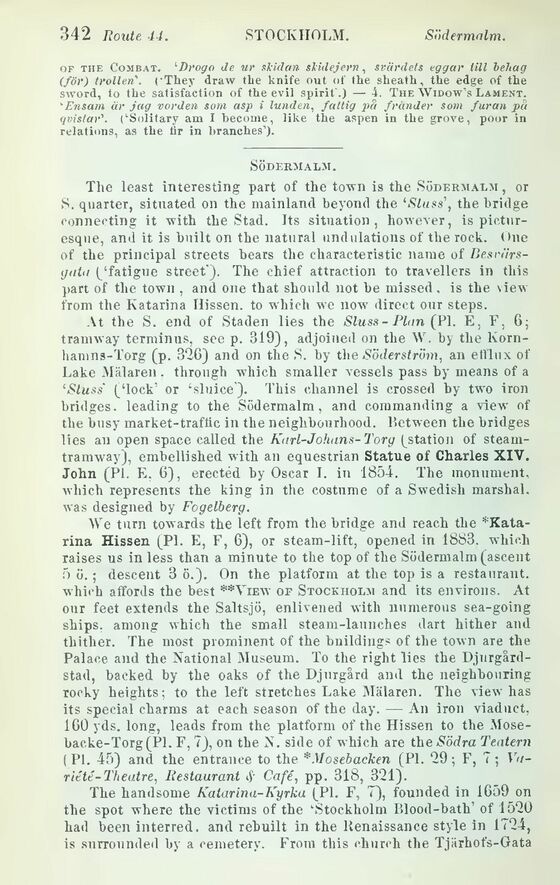
Full resolution (JPEG) - On this page / på denna sida - Sweden - Pages ...

<< prev. page << föreg. sida << >> nästa sida >> next page >>
Below is the raw OCR text
from the above scanned image.
Do you see an error? Proofread the page now!
Här nedan syns maskintolkade texten från faksimilbilden ovan.
Ser du något fel? Korrekturläs sidan nu!
This page has never been proofread. / Denna sida har aldrig korrekturlästs.
of the Combat. ‘Drogo de ur slidan siidejern, svärdets eggar till behag
(för) trollen’. ("They draw tlie knife out of the sheath, the edge of the
sword, to the satisfaction of the evil spirit .) — 4. The Widow’s Lament.
‘Ensam är jag vorden som asp i lunden, fattig på fränder som furan på
qvislar’. (‘Solitary am I become, like the aspen in the grove, poor in
relations, as the tir in branches’).
SÖDERMALM.
The least interesting part of the town is the Södermalm , or
S. quarter, situated on the mainland beyond the ‘Sluss1, the bridge
connecting it with the Stad. Its situation, however, is
picturesque, and it is built on the natural undulations of the rock. One
of the principal streets hears the characteristic name of
Besriirs-(jata (/fatigue street’). The chief attraction to travellers in this
part of the town , and one that should not be missed, is the view
from the Katarina Hissen, to which we now direct our steps.
At the S. end of Staden lies the Sluss-Plan (Pl. E, F, 6;
tramway terminus, see p. 319), adjoined on the W. by the
Korn-hamns-Torg (p. 326) and on the S. by the Söderström, an efflux of
Lake Mälaren . through which smaller vessels pass by means of a
‘Sluss’ (‘lock’ or ‘sluice’). This channel is crossed by two iron
bridges, leading to the Södermalm, and commanding a view of
the busy market-traffic in the neighbourhood. Between the bridges
lies an open space called the Karl-Johans- Torg (station of
steamtramway), embellished with an equestrian Statue of Charles XIV.
John (Pl. E, 6), erected by Oscar I. in 1854. The monument,
which represents the king in the costume of a Swedish marshal,
was designed by Fogelberg.
Mre turn towards the left from the bridge and reach the
*Kata-rina Hissen (PL E, F, 6), or steam-lift, opened in 1883. wTiic.h
raises us in less than a minute to the top of the Södermalm (ascent
5 Ö.; descent 3 ö.). On the platform at the top is a restaurant,
which affords the best **View of Stockholm and its environs. At
our feet extends the Saltsjö, enlivened with numerous sea-going
ships, among which the small steam-launches dart hither and
thither. The most prominent of the buildings of the town are the
Palace and the National Museum. To the right lies the
Djurgård-stad, backed by the oaks of the Djurgärd and the neighbouring
rocky heights; to the left stretches Lake Mälaren. The view has
its special charms at each season of the day. — An iron viaduct,
160 yds. long, leads from the platform of the Hissen to the
Mose-backe-Torg(Pl. F, 7), on the N. side of which are the Södra Teatern
(Pl. 45) and the entrance to the *Mcsebacken (Pl. 29; F, 7;
Varieté-Theatre. Restaurant 4’ Café, pp. 318, 321).
The handsome Katarina-Kyrka (Pl. F, 7), founded in 1659 on
the spot where the victims of the ‘Stockholm Blood-bath’ of 1520
had been interred, and rebuilt in the Renaissance style in 1724,
is surrounded by a cemetery. From this church the Tjärhofs-Gata
<< prev. page << föreg. sida << >> nästa sida >> next page >>